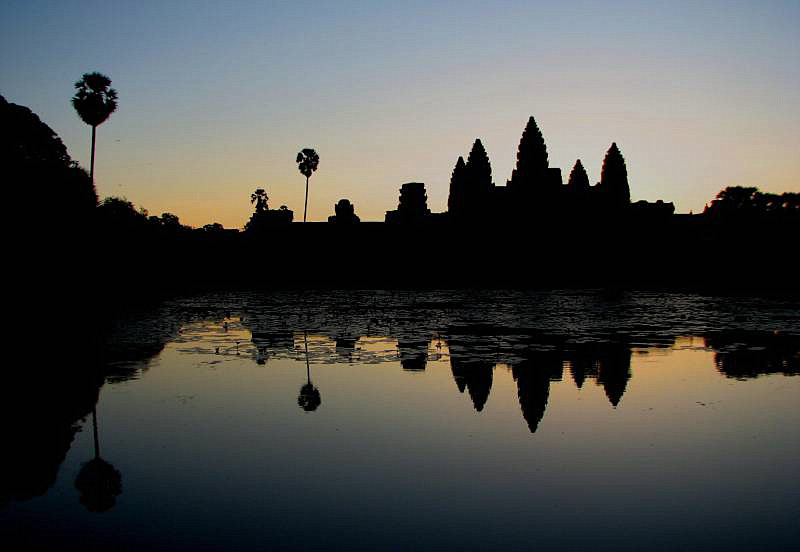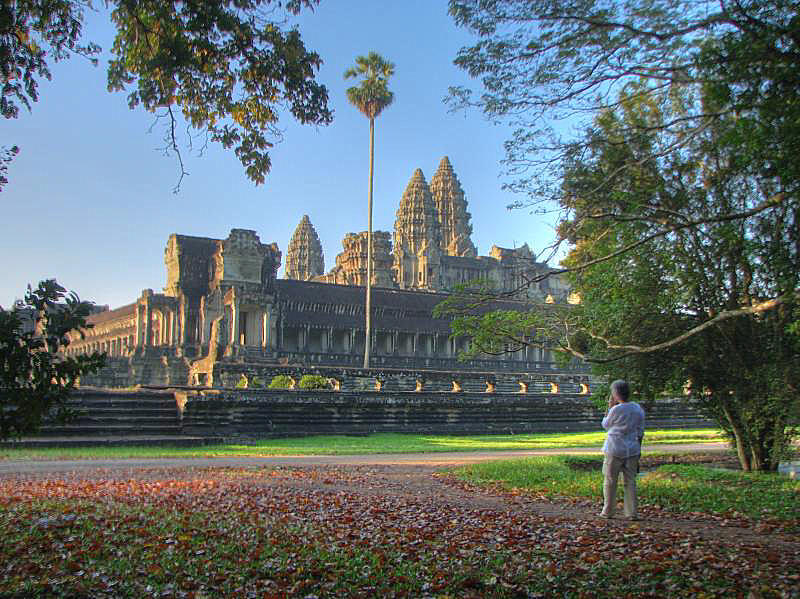Where we stayed in Siem Reap
| |
| Golden Temple Villa
|
|---|

| Golden Temple Villa staff, and us
(855) 12 943 459, email: temple_angkor@hotmail.com;
Website: www.goldentemplevilla.com
| |
We would highly recommend the Golden Temple Villa.
The rooms were good (we had plenty of space, air conditioning, an ensuite and
a balcony – although the view was poor; we were not at the front), the price was good ($20 per night), there was always someone at reception who spoke good English, we had a free pick-up waiting for us at the airport, free welcome drink, free (and reliable) Internet access, a free 20 minute massage and a good restaurant right adjacent.
As you can see from the photo, the decoration and landscaping were excellent as well.
Oh, and the rooms have colour TV too; but Denece and I hardly watched TV while we were in SE Asia, there seemed plenty of other things to do.
A curious thing about both Cambodia and Laos is that streets do not necessarily have names.
This is apparently the case with the street on which the Golden Temple Villa is on; so I can't give an address, but it is in the guide books and on Trip Advisor.
Mey Mey Restaurant
On the same (unnamed) street Golden Temple Villa, even cheaper, and good food.
Their coffee, in particular, was good and was served in the genuine
traditional style.
Out of curiosity I ordered a Greek Salad at Mey Mey.
(Denece and I mostly made a point of eating local styles of foods rather than those that we could eat at home.)
The Greek Salad had no lettuce nor any fetta cheese; the restaurant owner
apologised for not having olives, she had run out.
| |
| Tuk-tuk transport – well ventilated, suits the climate
|
|---|
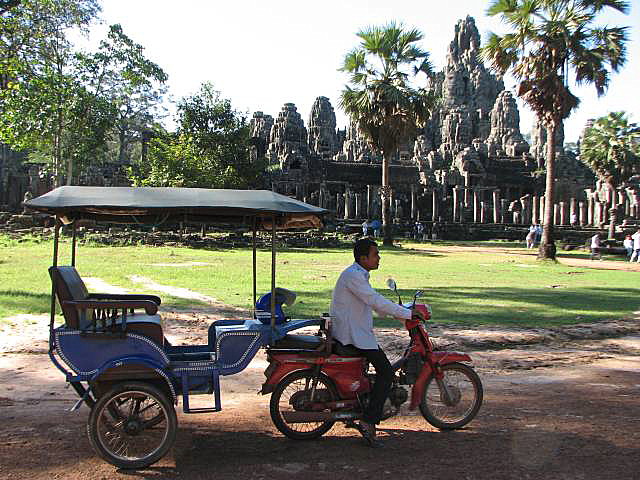
| Mr Kim Seng and his tuk-tuk at Angkor Thom
Phone number 0977291328
| |
There are several ways of getting around Siem Reap and the temples.
In the old part of Siem Reap walking is highly practicable; distances are small and finding one's way about is not difficult.
For the wider area of the temple complexes, some people travel by car (comfortable, fast, relatively expensive), bicycle (for the fitter people, who don't mind working up a sweat), and tuk-tuk.
We used the latter.
(Compare with Luang Prabang
tuk-tuk.)
The weather at Siem Reap is usually hot.
My wife and I found travelling by tuk-tuk comfortably cool because we were
completely open to the breeze created by the movement, which was typically
around 50 km/h, at a guess.
Mr Kim Seng's services were good, and his charges reasonable; his English,
though, was very limited.
He could talk about places to go, but his very limited vocabulary made anything beyond this difficult or impossible.
| |
| Foot massage by fish
|
|---|
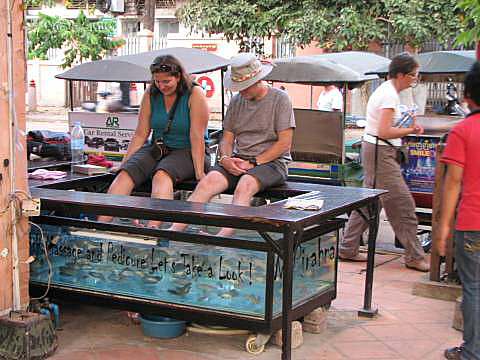
| |
| |
A trendy and probably quite new thing to do in Siem Reap is to have your feet
'massaged' by fish.
There were quite a few aquariums like the one in the photo set up so that people could sit on the side and hang their feet in.
The fish would presumably nibble the dead and dry skin.
On the end of the tank is written "No pirahna".
Wat Preah Prom Rath is on the western side of the old market area of Siem Reap.
(There is another temple/monistery across the river; Wat Damnak.)
As can be seen, the scafolding is all made of bamboo.
It is interesting to note that the thin nobby columns in two of the visible
windows are very similar to those on some of the ancient temples.
Bricks similar to these seem to be used exclusively in SE Asia.
The people seem not to use the solid clay bricks that are normally used in
Western nations at all.
Compared to the solid Western-style bricks, these would have slightly less
load-bearing strength, but significantly
better insulation properties (because of the air spaces) and would be lighter
to transport and work with.
These were in Cambodia.
Bricks in northern Vietnam seamed typically to be thiner and have only two
holes, those in southern Vietnam were of a similar size to these and had
six holes.
This is part of a temple, but similar brickwork was used on many other types
of buildings.
I don't remember seeing solid clay bricks anywhere.
Helmets and lights on bikes
Tuk-tuk drivers seemed always to wear helmets, while perhaps only about
half of other motor bike riders did.
If I remember rightly, few if any bicycle riders wore helmets.
At night motor bikes had lights, but less than half of bicycles had head
lights; almost no bicycles had tail lights or even reflectors on the back.
| |
| Jimmy's Village School
|
|---|
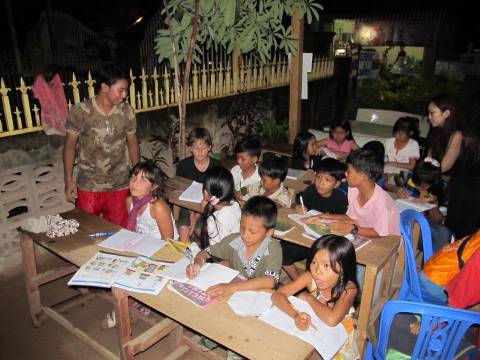
| Jimmy is on the left
Image credit: Jimmy's Village School
http://www.facebook.com/groups/189594284440704/
| |
This is a free evening school for children wanting to learn English; on
the same (unnamed?) street as the Golden Temple Villa.
English is seen as the international language by people in SE Asia.
In conversation with several university students at Dalat, Vietnam, I was
surprised to learn how much lower on the desirability scale Chinese was;
English was seen as being far more valuable as a second language.
Jimmy Chan Sarath had set up a little school in front of his Aunt's house.
(Jimmy's Aunt did laundry; she did ours while we were in Siem Reap).
Denece and I felt that Jimmy's Village School was a valuable initiative and that Jimmy was doing great work with the kids.
Email Jimmy at jimmysvillageschool@gmail.com or look up the Facebook group
"Jimmys Village School".
